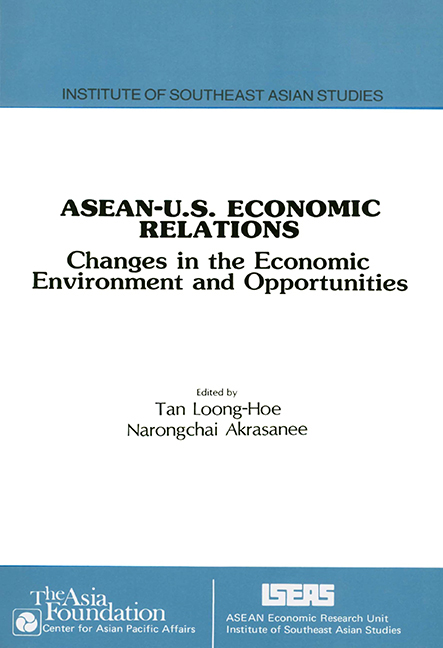Book contents
- Frontmatter
- Contents
- List of Tables
- List of Figures
- Foreword
- Changes in the ASEAN-U.S. Economic Environment and Opportunities: An Introductory Overview
- PART I ECONOMIC TRENDS
- PART II STRUCTURAL ADJUSTMENTS
- PART III TRADE IN SERVICES
- 5 ASEAN-U.S. Trade in Services: An ASEAN Perspective
- 6 U.S.-ASEAN Trade and Investment in Services: An American Viewpoint
- PART IV ROLE OF PRIVATE SECTOR
- THE EDITORS
6 - U.S.-ASEAN Trade and Investment in Services: An American Viewpoint
from PART III - TRADE IN SERVICES
Published online by Cambridge University Press: 21 October 2015
- Frontmatter
- Contents
- List of Tables
- List of Figures
- Foreword
- Changes in the ASEAN-U.S. Economic Environment and Opportunities: An Introductory Overview
- PART I ECONOMIC TRENDS
- PART II STRUCTURAL ADJUSTMENTS
- PART III TRADE IN SERVICES
- 5 ASEAN-U.S. Trade in Services: An ASEAN Perspective
- 6 U.S.-ASEAN Trade and Investment in Services: An American Viewpoint
- PART IV ROLE OF PRIVATE SECTOR
- THE EDITORS
Summary
In recent years the United States has experienced a significant increase in international trade in services. Whereas in 1970 U.S. exports of private services (travel, passenger fares, transportation, royalties and fees, and other miscellaneous private services) amounted to $9.6 billion, in 1983 they reached a sum in excess of $41 billion. Likewise, U.S. imports of private services increased from $9 billion in 1970 to $36 billion in 1983 (lable 6.1).
During the 1970-83 period the United States ran an increasing deficit in its balance on the merchandise account. Although there were surpluses in 1970, 1973, and 1975, these years were exceptions to the general trend of an increasing deficit. However, in contrast, the United States experienced an increasing surplus in its balance of private services during this period (with the exception of 1972). As can be seen in Table 6.2, these surpluses helped partially offset the deficits on the merchandise account.
The figures in the tables do not, however, reveal the full extent of U.S. international transactions in services and their contribution to the balance of payments. In recent years U.S. service industries have rapidly increased direct foreign investment, raising their share of the total U.S. foreign investment position from 20 per cent in 1975 to 25 per cent in 1983. This means that U.S. service firms now carry out a significant portion of overseas sales through their foreign affiliates and that a large share of the growing income on U.S. foreign investment should be attributed to direct foreign investment in service industries (Table 6.1).
What are the implications of these changes in the pattern of U.S. international transactions in services for ASEAN-U.S. economic relations? This is a question of some importance to both the ASEAN countries and the United States, as the former are some of the most rapidly developing countries in the world and thus may provide a potentially significant market for U.S. service industries. The United States is, of course, a major trading partner of the ASEAN countries, and hence whatever happens in the U.S. economy warrants careful scrutiny for its effect on the ASEAN economies.
- Type
- Chapter
- Information
- ASEAN-U.S. Economic RelationsChanges in the Economic Environment and Opportunities, pp. 146 - 174Publisher: ISEAS–Yusof Ishak InstitutePrint publication year: 1988



